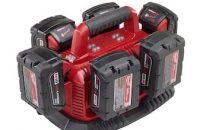Imagine robot sprayers guided by 3D “printing” instructions constructing the shell of a house, store, apartment building or office could in just one day without an on-site workforce. It’s already happening on an experimental basis in China, and could one day transform the U.S. market as well. “This technique allows you to construct strong buildings Read more
2015 June – July

Imagine robot sprayers guided by 3D “printing” instructions constructing the shell of a house, store, apartment building or office could in just one day without an on-site workforce. It’s already happening on an experimental basis in China, and could one day transform the U.S. market as well.
“This technique allows you to construct strong buildings more quickly at a much lower cost and with great architectural flexibility,” said Behrokh “Berok” Khoshnevis, an industrial engineering professor at the University of Southern California’s Epstein Department of Industrial & Systems Engineering in Los Angeles, “Because less labor is required, the construction is much safer for the field workforce.” To bring the 3D printing process into the private sector, Khoshnevis launched Contour Crafting, and plans to build a demonstration home in the near future using robots that spray layer after layer of concrete material in a precisely controlled pattern.
While Khoshnevis knows it will take time for this innovative process to catch on, he believes it can eventually transform the market – particularly for the affordable housing market. “Most people will continue to build with wood, steel and glass, butt there is a real need for this technology,” he said in an interview with Perspective Media. “We plan to license this technology, which can bring affordable housing to communities around the world.”
How it works

At the 2013 “Inside 3D Printing” conference in San Jose, Khoshnevis explained how Contour Crafting has addressed the challenges facing large-scale layered fabrication technology. Once the 3D design for a home or other structure has been completed, it needs to be “printed” in the real world environment.To do so, a 3D printer weighing 500 pounds could be mounted on a gantry frame and brought to a construction site. It could also be placed on rails to move back and forth on a street, constructing multiple houses in sequence. Then, one or more robotic “arms” would move around the construction site, spraying concrete or a similar material – pumped from a truck – according to the printer’s 3D instructions. The robotic machines would gradually move higher on the walls and eventually to the roof of the structure as the layers of material accumulate.
One of the biggest challenges to the process was creating a mechanism that could extrude wet cement with a special hardener so it would keep its form as each successive layer is printed. “With this process, it’s possible to construct a 2,000-square-foot house, including the floors, walls and roof, in less than 20 hours,” Khoshnevis said at the conference.
Integrating functional components
One of the big questions for the building trades is how functional components like plumbing, heating, HVAC and electrical systems can be integrated into a 3D printing system. Here are several examples of the process.
- HVAC. Basically, the robot sprayer would create a solid housing for the heating, ventilation or central air-conditioning systems, which would then be installed by contractors in those trades.
- Plumbing. Khoshnevis says the Contour Crafting process has the potential to build utility conduits within walls. “This makes plumbing automation possible,” he added.
After fabrication of a certain number of wall layers, a segment of copper (or other material) pipe may be attached onto the lower segment already installed inside the conduit. The robotics system delivers the new pipe segment and has a heater element in the form of a ring. The inside (or outside) rim of each pipe segment may be pretreated with a layer of solder. The heater ring heats the connection area, melts the solder, and once the alignment is made, bonds the two pipe segments. “PVC plumbing is also possible by using adhesives for pipe connections,” he said.
- Electrical. A modular approach similar to industrial bus-bars may be used for automating electrical and communication line wiring. The modules have conductive segments for power and communication lines, and interconnect modularly. All modules may be robotically fed and connected.
“A simple robotic gripper on manipulator attached to a Contour Crafting machine can perform the task of grabbing the component and connecting it to the component already placed within the conduit,” Khoshnevis said. “The automated construction system properly positions these modules behind the corresponding openings on the walls. The only manual part of the process is inserting fixtures into the automatically constructed network.”
- Sensors. Sensors and other devices can be implanted in certain segments of the building. “Discrete sensors may also be densely placed by a robotic arm at pre-specified locations inside any type of construction material for in-process feedback for construction process control,” he said. They also provide means for inspection and tracking variables such as temperature, humidity and vibration in completed structures.”
- Insulation. Insulation as well as finish work, such as plastering of walls may be achieved by using a hybrid Contour Crafting nozzle that delivers multiple materials such as concrete, polyurethane, and plaster. After the walls are constructed, a conventional spray painting robotic manipulator driven by the same 3D instructions may paint each room according to desired specifications. “The painting mechanism may be a simple spray nozzle, or a large inkjet printer, making it possible to print wall paper or other desired patterns,” Khoshnevis said.
- Tiling. Tiling of floors and walls may be automated by robotically delivering and spreading grout and adhesives to the flooring. Another robotics arm would pick the tiles from a stack and accurately place them over the area treated with the adhesive material. “Often 60 percent of the time in manual tiling could be spent on alignment,” Khoshnevis said. “With an accurate robotic infrastructure in place alignment will not be an issue at all.”

Benefits of 3D printing
First developed more than 25 years ago, the 3D printing process involves creating solid objects from digital files using thin layers of plastics or other quick-drying substances like concrete. Layer after layer of material is laid down automatically, until the entire object is created.
“With this process, a single house or a neighborhood of home, each with a different design, could be automatically constructed in a single run,” Khoshnevis said. “The potential applications of this technology are include low-income and commercial housing.”
While it takes six to nine months to construct an average house in the U.S., Contour Crafting can complete custom-designed houses in a single day. “Worldwide, we will offer dignified but affordable housing constructed for low income populations,” he said. “We can also create comfortable and livable emergency shelters (not tents) for long-term usage by disaster victims.”
Khoshnevis says other benefits of the 3D printing process include a steep reduction in building wastes and harmful emissions during the construction process.
One of the advantages to Contour Construction’s approach is the ability to offer curvilinear architectural designs rather than traditional rectangular boxes, Khoshnevis added. “These new designs can give a fresh appearance to neighborhoods and cities.”
Looking to the future, Khoshnevis said 3D printers and automated robots could be used to construct livable habitats on the moon and Mars, which are targeted for human colonization before the end of the 21st century. In fact, Contour Crafting beat more than 1,000 other companies around the world to win the grand prize in NASA’s 2014 Tech Briefs “Create the Future Design.”
While 3D printing technology still needs to establish itself in the U.S. construction industry, it’s clear that this innovative technology has the potential to change other worlds, as well as the Earth.

People may not associate plumbers with technology, but the modern plumber knows that technology makes his job much easier. From offering customers better products and services to managing the office and fleet more effectively, modern technology is helping the plumbing industry evolve. Here are some trends to watch if you are in the field: Technology Read more
People may not associate plumbers with technology, but the modern plumber knows that technology makes his job much easier. From offering customers better products and services to managing the office and fleet more effectively, modern technology is helping the plumbing industry evolve. Here are some trends to watch if you are in the field:
Technology to Improve Customer Comfort and Health
It is not uncommon for a household to experience leaks. While some may go unnoticed, others may result in increased water bills. If you suspect your tap could be leaking, you can best handle the situation by contacting Mr Flow plumbing services to discover the best repair for such leaks.
Getting a leaking tap fixed could save you money spent on water bills and save thousands of liters of water yearly. Besides having a plumbing company resolve the issue, ensure that you always close all the taps tightly.
Today, there is high-end technology plumbing contractors use to deliver quality plumbing services. By hiring the right company with such tools, you will avoid regretting your decision in the future. This is because the problem will have gotten a permanent solution that does not need constant repairing. It would be best to do your research and identify all emerging trends now and then.

Technology Focused on Green Living
Going green” is no longer a fad; it is now deeply ingrained into today’s society. According to Hardware Retailing, 47 percent of retailers who sell plumbing products indicated that they had customers actively seeking green products for their plumbing systems. For modern plumbers, adding these into their service offerings is not just a good idea for customer service, but also a good idea for overall business growth.
Technology is helping in several ways: Consider, for example, the dishwasher. New dishwasher technology that recycles rinse water for the wash cycle can save the average family as much as 700 gallons of water a year. Home automation technology that automatically shuts off sprinkler systems based on weather reports can also help save water. Plumbing contractors that can offer these services will find themselves in high demand.
Using greywater (water that runs down the sink drain or shower drain) for other purposes in the home, such as flushing the toilet, is another water-saving innovation, and this is one area where the services of a plumber are absolutely necessary. Once installed, a greywater system can save a significant amount of money, but only a licensed plumber is able to set up the complicated system. Plumbing professionals that can learn how to offer these services will be in an excellent position to gain new clients.
Technology to Improve Customer Comfort and Health
In addition to saving water and energy, customers are looking for plumbing technology that makes them more comfortable and healthier at home. For instance, technological advancements that make toilets and faucets “touchless” are becoming increasingly popular in the home. Customers enjoy being able to close the lid, flush the toilet and wash their hands without having to touch germ-infested surfaces.
Water filtration systems are increasingly on demand as consumers are learning more about the dangers of tap water. Reverse osmosis filtration systems are a popular option in the modern home, because customers want instant access to clean drinking water.
Shower technology is also making the home experience more comfortable. Luxury faucets and showerheads can turn the home shower into a spa-like experience. Plumbers who can offer these types of upgrades to their customers will meet a growing need in the industry.
Technology to Streamline the Fleet
Most plumbing companies have a fleet of service vehicles they dispatch to deliver their services to clients; technology can make vehicle management more efficient.
GPS fleet tracking technology, for instance, allows the dispatcher to know where vehicles are and what the best route for them to take is. This limits wasted fuel from poorly planned routes and ensures drivers arrive on time. It can also limit wasted time and mileage when drivers take personal trips in company vehicles, because the technology provides a level of accountability.
With GPS fleet tracking, companies can improve customer service by ensuring that drivers are on time to their service calls. This is important, because 67 percent of customers will not do business again with a company that sends a technician an hour late, according to Software Advice, a service that assists plumbers in finding field service software. Sending drivers on time using the most productive route, and estimating arrival times accurately, requires the use of GPS fleet tracking.
Whether technology is improving the work of the plumber or the customer experience, the fact remains that it is changing the face of the industry. To ensure that your plumbing business remains relevant, be sure to keep up with these changes.
Robert J. Hall of Track Your Truck is president of one of the leading GPS vehicle tracking systems for small and midsized companies.

PVC terminology can be confusing for a lot of people, so we’ve put together an easy-to-understand glossary. Here is list of some of the more common PVC terms: ASTM – This stands for the American Society for Testing and Materials, which sets several international standards for not only PVC fittings and pipes, but also CPVC Read more
PVC terminology can be confusing for a lot of people, so we’ve put together an easy-to-understand glossary. Here is list of some of the more common PVC terms:
ASTM – This stands for the American Society for Testing and Materials, which sets several international standards for not only PVC fittings and pipes, but also CPVC materials.
Bell End – This is a pipe that flares out at one end so another pipe can connect without a coupling. Connections are typically made by using adhesives, mechanical techniques or solvent cements.
Blister – An imperfection in a piece of plastic typically due to excessive pressure or temperature, not using enough adhesive, or not curing the material for the proper amount of time.
Compact Ball Valve – A small valve, usually made of PVC, that offers on/off functionality. It is typically inexpensive because it cannot be easily repaired or taken apart.
Conversion – The result of processing a raw material into a usable form. For example, plastic pellets are often converted into films. Conversion usually entails mixing together additives and polymers, melting and extruding them, and then shaping and solidifying to create the final product.
Coupling – A type of fitting that joins two pieces of pipe.
CPVC – Chlorinated Polyvinyl Chloride — it has similar resistance to chemicals and corrosion as PVC, but can tolerate a higher temperature (200 degrees Fahrenheit compared to 140 degrees Fahrenheit).
Diffusion – Movement of gas, liquid or another material through plastic.
EPDM (Ethylene Propylene Diene Monomer) – A form of rubber commonly used to seal valves and fittings made of PVC material.
Fitting – This is a portion of a pipeline used to connect sections of a pipe. It comes in a wide range of materials, sizes and shapes.
Gasket – A device used to create a watertight seal between two different surfaces.
Infiltration – The intrusion of water into a sewer system from the ground. It typically occurs due to defective connections, pipes, joints and other factors.
Injection Molding – The process of using granular or powdered plastics to make plastic products. It is typically performed by using heat and a great deal of pressure to fuse the material inside a chamber. The heated mass is then forced into a cooler area so it can solidify.
NPT (National Pipe Thread) – This is the United States standard governing tapered threads.
Operating Temperature – This is the temperature a pipe can typically tolerate and still be able to function properly. The highest operating temperature for PVC pipe is 140 degrees Fahrenheit.
O-Rings – Circular gaskets commonly found in valves and fittings made of PVC. They create a watertight seal between two pieces of a plumbing system.
Pipe Dope – Slang for pipe thread sealant, the flexible material typically applied to fitting threads prior to installation. Pipe dope is designed to result in a long-lasting, watertight seal.
PSI (Pounds per Square Inch) – A measurement of the maximum amount of pressure a fitting, valve or pipe can tolerate.
PVC (Polyvinyl Chloride) – Used regularly in a wide variety of consumer and commercial products, PVC is a rigid, thermoplastic material that is chemical resistant and corrosion resistant.
Schedule 40 PVC – The “schedule” is the thickness of a pipe’s wall. Schedule 40 is the most commonly used thickness of PVC in irrigation and home projects. It is typically colored white.
Schedule 80 PVC – This is usually gray and has a thicker wall than Schedule 40. As a result, it can tolerate higher pressures and is more appropriate for industrial and commercial use.
Union – A fitting used to connect two pipes. It differs from a coupling in that it uses a gasket seal to create the connection.
Working Pressure – The amount of pressure recommended for use on a fitting, valve or pipe. It is frequently denoted in PSI.
Again, these are just some of the many common terms used by professionals in the PVC industry. If you have any questions or need further definitions, talk to a local PVC dealer.
Author Bio:
Amanda Hill is the content manager at PVC Fittings Online, a leading supplier of PVC Supplies and accessories for commercial contractors. Amanda is known as the Queen of PVC because of her knowledge of PVC Pipes. Visit their resource center today to learn more about PVC piping.

by Jim Hinshaw Recently, I heard a story of a Viet Nam Vet who was at a restaurant having a dinner with his wife when a stranger comes up to him and calls him out by name. He asked the Vet how he was doing. He responded, “Do I know you?” The stranger says, “Yeah, I packed Read more
by Jim Hinshaw
Recently, I heard a story of a Viet Nam Vet who was at a restaurant having a dinner with his wife when a stranger comes up to him and calls him out by name. He asked the Vet how he was doing. He responded, “Do I know you?” The stranger says, “Yeah, I packed your chute back in the day.” This supposed stranger was no stranger at all. In fact he was the ground support crew that made sure parachutes opened for the troops while flying missions over Nam. There’s nothing more critical than making sure you parachute opens when jumping out of an airplane. It’s the difference between life and death. This stranger literally kept this other Vet alive by packing his parachute correctly every time. Talk about having a guy’s back; this stranger literally did.
This got me thinking about contractors in our industry and the survival of your business. So who’s got your back to support you or even help save your business? Who can you call on when things don’t go exactly as planned? Many of you in this industry are in business for yourselves and sometimes it can be lonely running the shop by yourself. So whom can you call upon? You can’t talk to your employees if you have any because they have problems of their own and aren’t interested in yours. Friends don’t want to get involved and usually don’t understand your business and industry anyway.
So you need a person you can call upon when you are not sure what to do next and offer support to grow your business or even survive. You need a good chute packer who’s got your back. Do you have such a person in your life that’s a confidant and trusted advisor to help you get through the tough times and market swings this industry brings?
I happened to have married a chute packer, May, who always has my back and I have absolute confidence in that. She not only supports me, but she’s also completely honest in all aspects of our relationship, business and personal. That is what you want from a trusted advisor, the truth at all times. Even when there is bad news to be delivered, you need one who will deliver it and not sugarcoat the opportunity you are facing to simply make you feel good temporarily.
So how can you find such a trusted advisor that can support you with the challenges this business and life throws your way? Perhaps they may be someone you already know. In some cases, a family member may be able to help such as a relative who has been or still is in business and can share thoughts on your plan of action for your business.
In addition, there is no shortage of consultants on the planet; you can hardly swing a cat around by the tail without hitting one. OK, I know that’s sort of a stupid and non-politically correct phrase, but you see where I am going. There are consultants who have been in this industry and have bought and sold companies similar to yours. There are others who have had experience in different industries but have life lessons that apply across many industries and businesses that can help you with the issues you are facing. Ask other business owners whom you respect who they have used and how they have been helped to receive the results they achieved.
You can even interview a consultant and ask about their experience, how they have helped others and what they will do for you. Any consultant should be able to provide references and an action plan for your situation before going on the clock. Just ask.
Another source of trusted advisors are your business relationships, the sales reps calling on you. Many have been involved with contractors who have businesses similar to yours; they may have helped others grow their companies or have learned over time what separates one successful contractor from another. Ask your rep what advice he may have for your business as many have moved from being simply order takers to consultants that will work with you; and without charging additional fees. Many distributors have put together business programs addressing exit strategy, HR concepts, how to work with different generations, Quick Books, and many other concepts. So the next time your rep calls on you, ask him to have a cup of coffee with you at a local coffee shop. Ask for his help with your business or what he sees other successful contractors doing that you may also be able to implement.
A final source of help may be an industry group such as Service Roundtable. With full disclosure, I am a coach and partner in SR; it is the nation’s largest forum for HVAC, Plumbing, and Electrical contractors. It’s only $50 per month and you may interface with companies up to $50 million/year in sales. You can ask the group how they are doing GPS, health care, dispatching, almost anything, and be provided some great resources. It’s a huge bargain! Here is a link to save you $25 off the first month’s membership, from me! http://www.serviceroundtable.com/Hinshaw
Also be aware that none of us know everything about every business and even we can use outside support from time to time. But there is help and advice available all around us. Just do your investigative work and find the person who can fit your needs, budget, and who will defiantly have your back. With your business and livelihood at stake, It can be the difference between survival or going out of business. You need a good chute packer.
